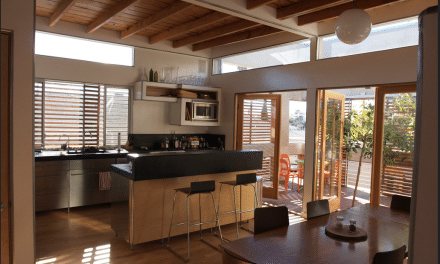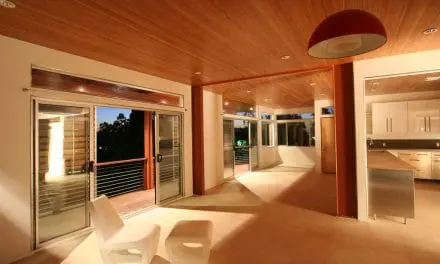Photos by Nolasco Studios
With its scalloped parapet, the U-shaped house perches at the crest of a ravine in the Mt. Washington neighborhood of Los Angeles. It hints of Mission style, but the façade is uncharacteristically shingled, with curvy eyebrow eaves above the windows. “Something you’ll never see,” said homeowner Stephen Pallrand, founder and principal owner of Home Front Build. His showcase home, his first CarbonShack branded project, achieved LEED Platinum with a West Coast–shingle mashup style.
Let’s just say the all-electric 2,495 sqft home borrows a little bit of this and a little bit of that. A quick scan reveals terra cotta Spanish Colonial style tiles, Craftsman framing, brick, and stucco. But these are salvaged clay roof tiles, saving 6.5 tons of CO2. Salvaged stone and brick, plus thousands of reclaimed redwood shingles in a bespoke pattern developed jointly by designer and craftsperson saved 4.5 tons of CO2 production just on the exterior.
Starting with a vacant 4,853 sqft lot, Pallrand modeled the carbon impact of the concrete foundation. It was huge: 68 tons of CO2! Incorporating 50% flyash (an industrial waste product) into the concrete mix shaved 34 tons of CO2 of the original estimate. For framing, the team rescued Douglas fir from a nearby 1905 Craftsman-style home that had been demolished. That repurposing alone saved around 2.75 tons of embodied carbon.
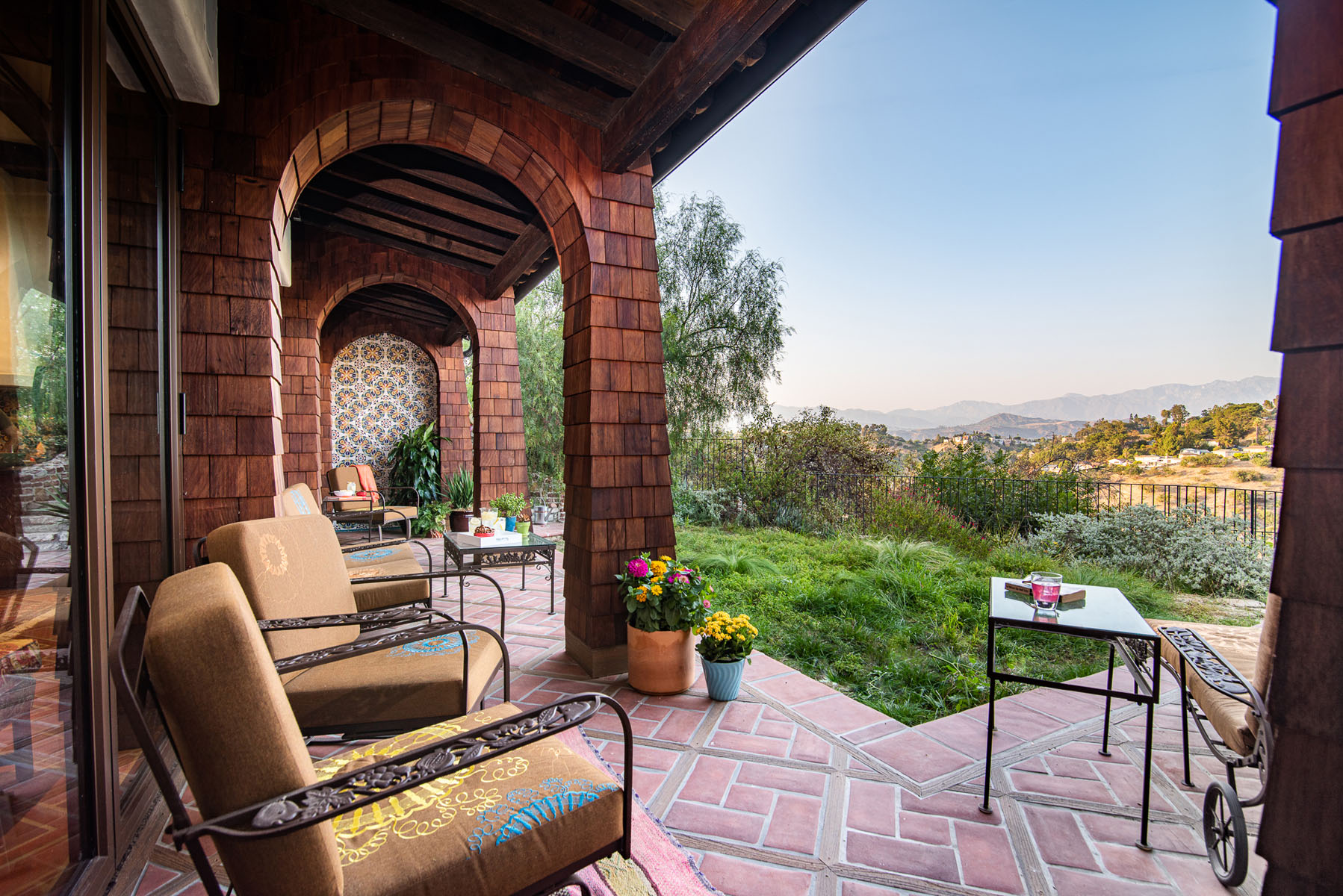
Sustainability unseen
But Pallrand wasn’t satisfied with that; especially if he were to use his home as a case study for carbon neutrality. For him, it was about all the stuff you don’t see. “The story of living sustainably is hidden,” says Pallrand. High efficiency plumbing and heating systems just aren’t that sexy.
Pallrand incorporated the basics that reduce the home’s operating carbon footprint. Double stud walls, with more than eight inches of insulation and holes covered with loose-fill cellulose save 0.50 tons of CO2 per year. A solar roof saves a little more than 3 tons of CO2 per year. A heat pump hot water heater constitutes still another step to net zero. Ceiling fans circulate heat and the whole-house fan provides cooling, saving about 0.95 tons of energy per year.

A banquette was crafted from mahogany from salvaged church pews. The story of the cycle of plants is told with carving on the back, while the dining table at center is carved with mycelium images.
Sustainable to be seen
Pallrand and his wife, Rachel Mayeri, a professor of media studies and an artist, had an aha moment. Why not design the interiors in a way that speaks to the nature all around us? In other words, design inspired by the microbiome. “The wild is not just out there,” says Mayeri. “It’s within our houses. This is a way to show that how and what we choose to build with and how we live impacts on nature.”
So they set to creating bespoke designs for their home, not merely products with vague references to nature. The designs are based on drawings of mold and bacteria, patterns under the microscope, microalgae, sea life, mycelium (fungal threads that live under the forest floor), and photosynthesis.” Tile, lighting (much of which was 3D printed), upholstery and window treatments, decorative iron railing and grates… Every finish and furnishing was fair game. Starting with the rustic mahogany paneled front door, whose carved inserts feature patterns mimicking mycelium cellular structure.
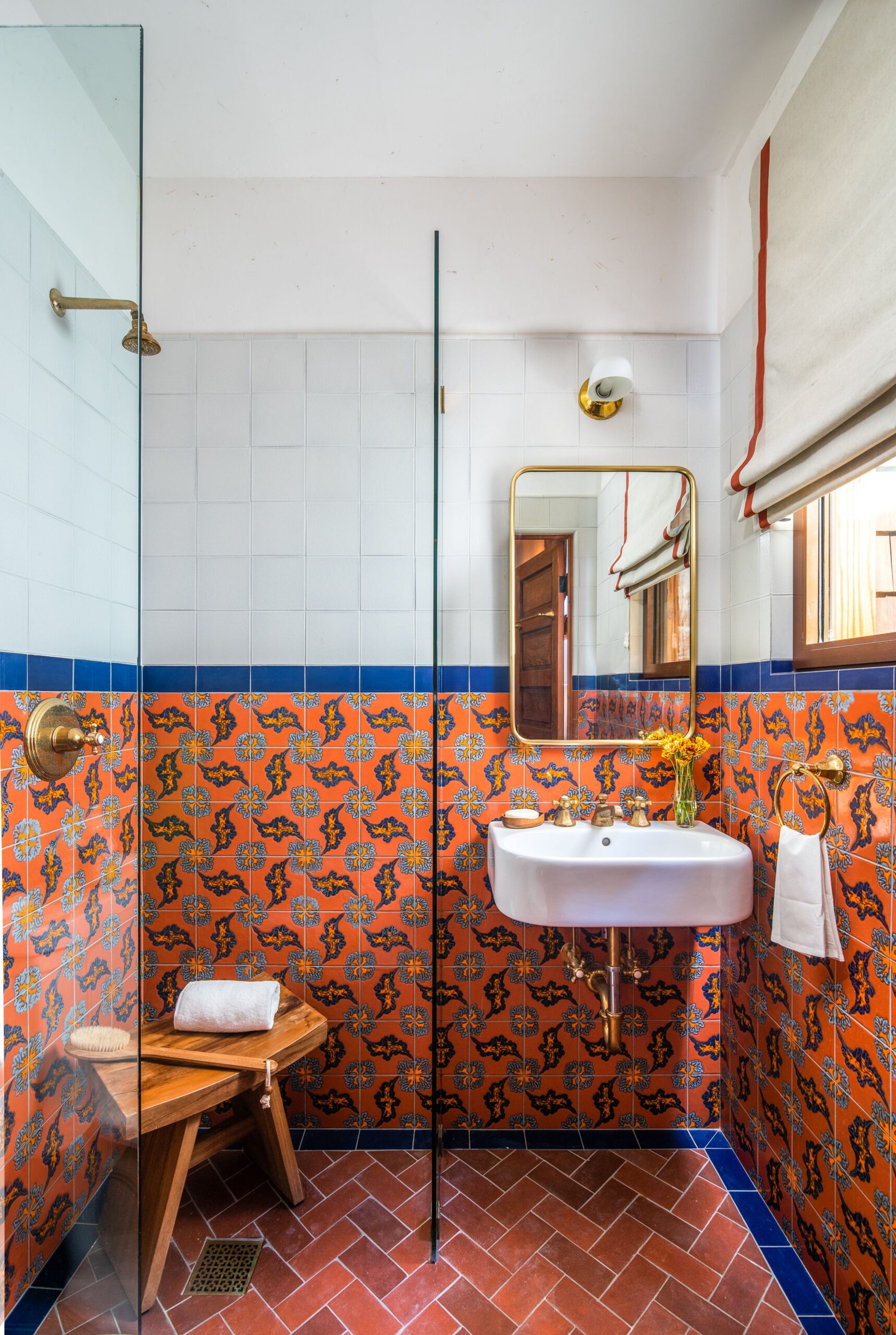
Slime mold is a type of single celled organism, a microscopic soil amoeba. This design is inspired by etchings by Ernst Haeckels. The tile is produced on red quarry clay bodies, with a cuerda seca technique.

Pallrand scored a complete group of vintage green bath fixtures from the thirties, which he paired with custom matching tiles, some solid, some with mycelium patterns.
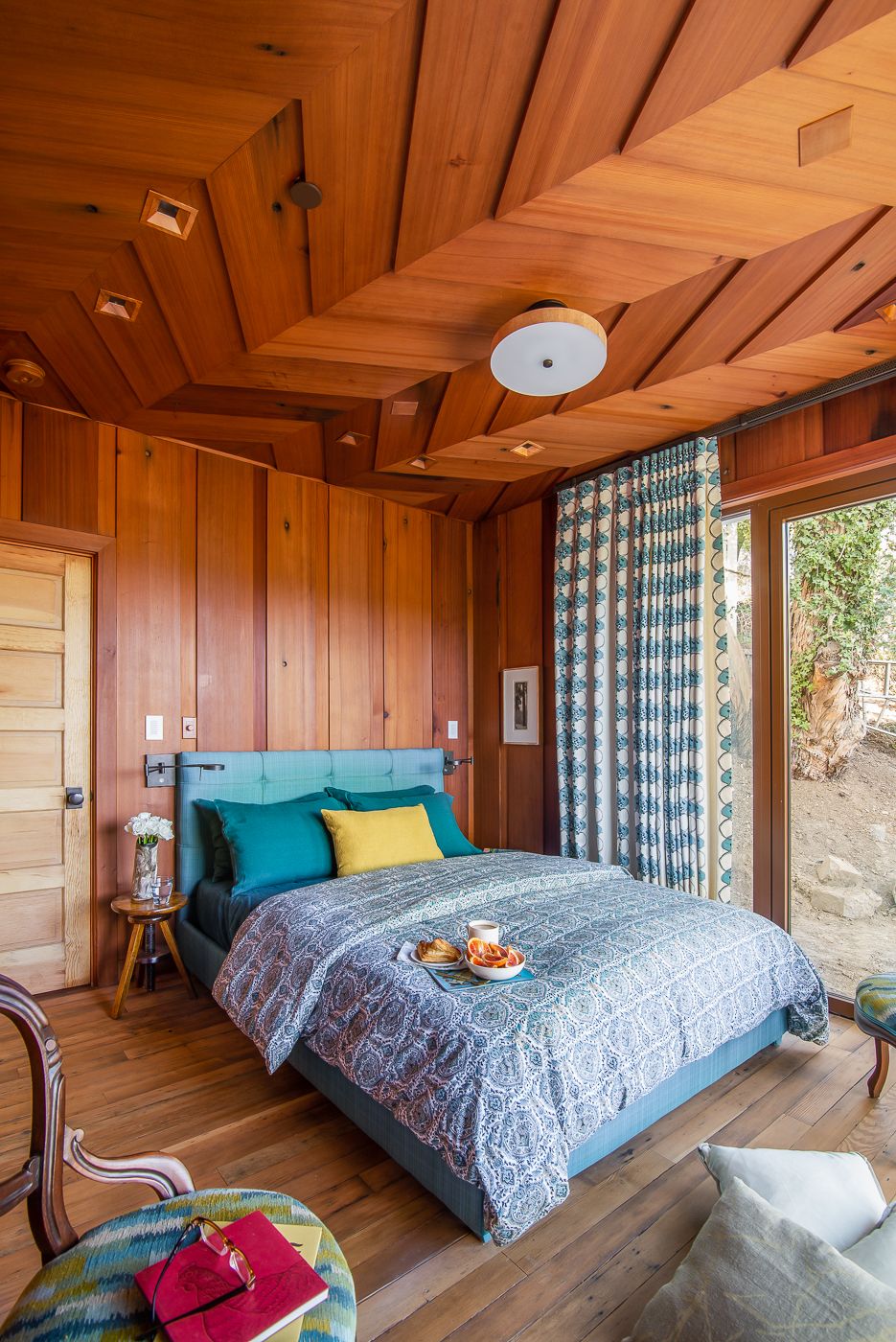
The ceiling of this bedroom is paneled in a chevron pattern with old growth redwood salvaged from a decommissioned 1920s Northern California bridge, which lends a sense of history.

The draperies in this bedroom are printed with a fungal spore pattern. As the “flower” of the invisible natural world, spores are microscopic eukaryotic organisms that blossom, seed, and reproduce their species.
It’s in their DNA
As an artist, Mayeri has been inspired by biology for years. “I love getting really cellular and microscopic, thinking about things not really seen as beautiful but chaotic and weird, like mycelium. And we have these very skilled artisans who crafted crazy, beautiful baroque designs of nature into our décor. I’m sure, on a cognitive level, we’re primed to see patterns in nature,” Mayeri said. She admits it was a kick to see her “E. coli” bath on the pages of The New York Times.
Mayeri’s father is a neuroscientist; her mother a ceramicist. Pallrand’s father was a physicist, who used to take him hiking and camping. An uncle was a subsistence farmer in the backwoods of the Adirondacks. “My dad was so intrigued with that way of living. It was the original circular economy. That was the genesis of my love of the environment.”

The plaster in all the bedrooms is thicker because it’s mixed with grass and straw to aid in carbon sequestration. It has a grass cloth texture. Blue and white textiles depict fern spores.
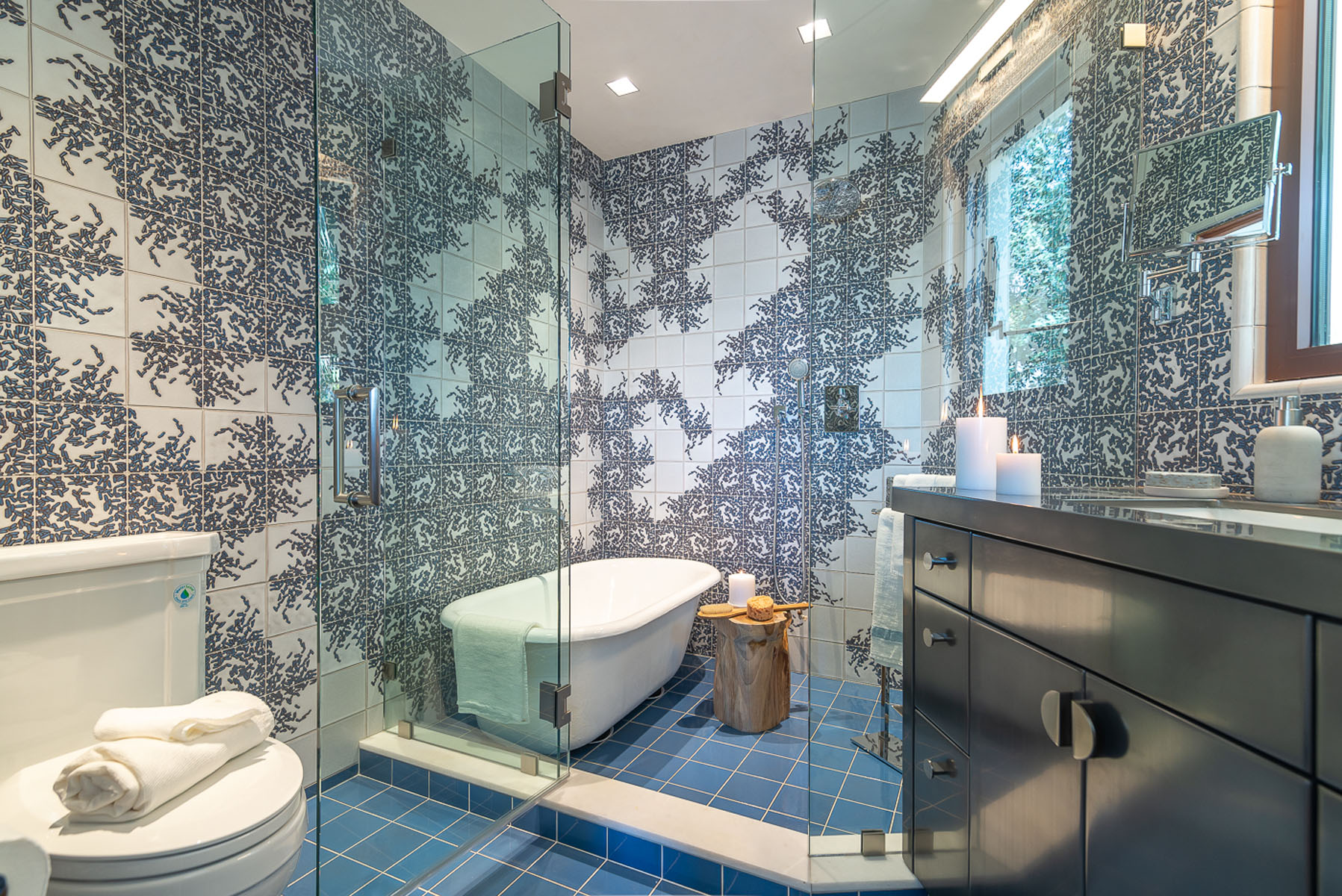
The bacterial colony tile is one of Rachel Mayeri’s favorites. Different patterns, based on microscopic images, create a colony. They’re placed to create a feeling that the bacteria is “creeping up and down the walls.”

The openplan kitchen/dining room has a Spanish Colonial feel, especially with its flooring of Saltillo-like tiles inlaid with salvaged Douglas fir wood parquet strips. The exterior shingles repeat indoors, framing the living space with an outdoor-indoor connection.
Three 12-foot wide folding doors open to the courtyard. Transom windows above bring in light and sky views.
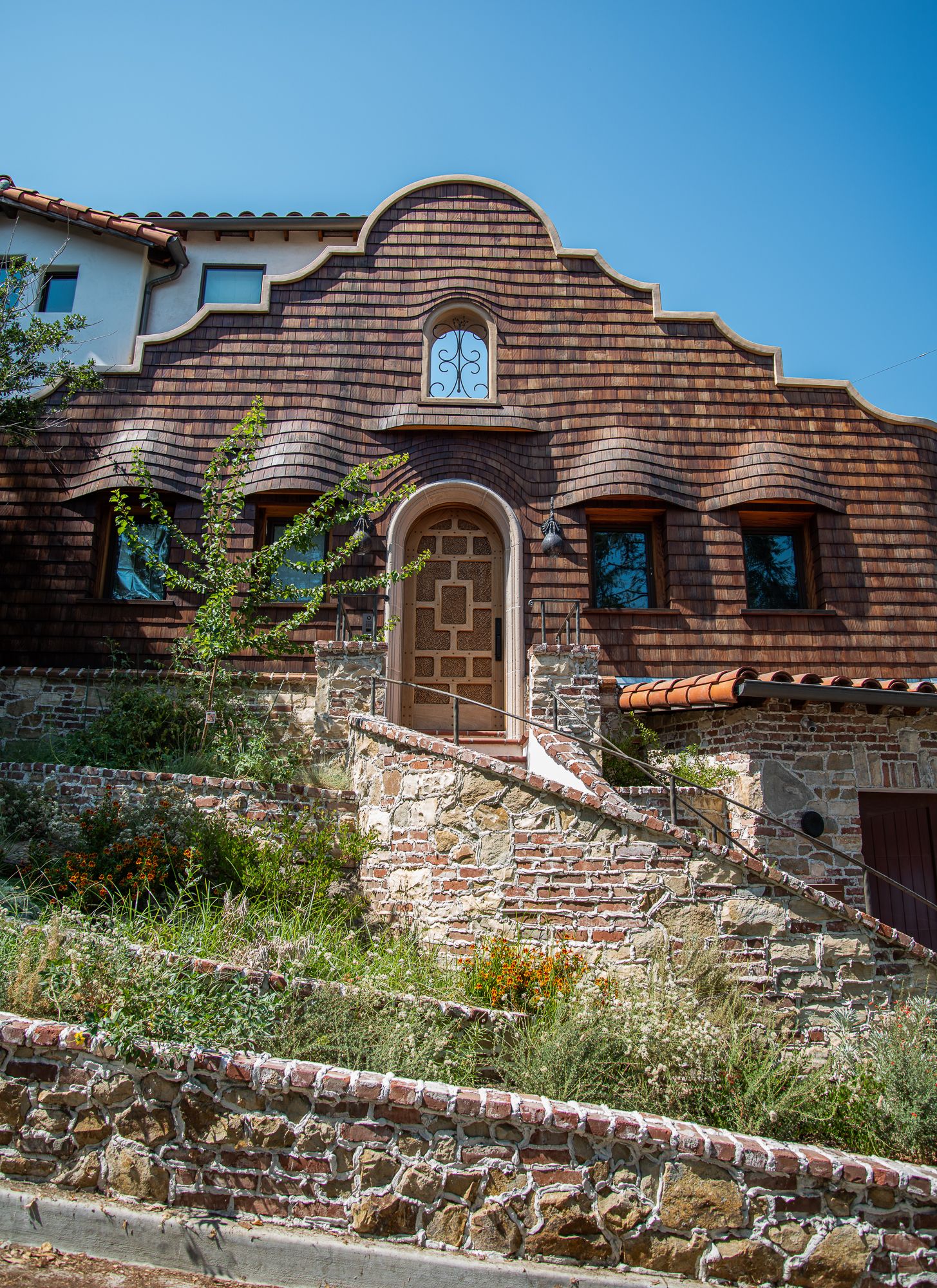
Salvaged materials and placement lend a quirky character to this home in the San Rafael Hills of Northeast Los Angeles. The Mission-style facade, craftsman-like redwood shake shingles, Spanish Colonial clay roof tile, and reclaimed brick all speak to sustainability.

And on the other side, stucco.

Handcrafted, biophilic design
An open plan helps the spaces live larger. CarbonShack’s Medusa Chandelier connects the kitchen and dining with the living area. Thalamphora pendants light the passageway leading to the north-facing courtyard and an outdoor entertainment area with a view of the San Gabriel Mountains.
We’ve got an in-depth look at CarbonShack’s lighting lines: “Made in LA: 3D Printing Meets Biophilic Lighting.”
Home Front Build’s design-build team includes framers, finishers, masons, plasterers, cabinet makers, hardware specialists, and tile setters. Just as they repurposed lumber for the house itself, Pallrand’s team created furniture from wood destined for landfill. “We came across some old church pews that were being thrown away,” he said. “They were made from Philippine mahogany from the 1920s.” They were made into lower cabinetry in the kitchen.
“It’s wonderful to carve,” says Pallrand, who fashioned highly carved dining and coffee tables, depicting the history of plants, as well as an intricately carved island front. “We make houses that have a feeling of humanity—that somebody made this. It’s like going to a farmer’s market and knowing who produced our peaches or our strawberries.”
Natural processes and materials
Because of the unusual shape of the site, the house is two levels on the north side and a split level on the west. A historical plastering process was incorporated into the wall finishes. One of Pallrand’s team members demonstrated techniques his grandfather taught him in Mexico. Adding straw to the plaster mix makes it go farther and adds texture. This technique is also used in medieval Japanese architecture and in Tudor construction in Germany. “We did it with grass from the hillside. And kept its natural color. I don’t like using paints, even low VOC.”
One of the more evocative installations is a bath teeming with bacteria. Patterns on tiles, that is. Mayeri designed the bacteria colony-inspired ceramics and had them installed to create the sense of “creeping up and down the wall and splashing up behind the toilet.” Green fixtures in a second bath were castoffs from a Spanish Colonial revival home from the 1930s. “It’s very rare that you find a set: toilet, tub and sink. I was charmed by it. Loved the color.”
In one bedroom, walls are gloriously paneled with redwood from a 1920s-era Northern California bridge. The paneling runs right into the ceiling, where it’s saw toothed and staggered, leading the eye to the view outdoors.
Textiles for draperies, Roman shades, and upholstery are sustainable hemp, with screenprinted patterns of fern and fungal spores, mycelium, and radiolaria (a tiny protozoan that leaves an intricate silica skeleton).

The office and den are appointed with some of the furniture sold on the CarbonShack website. The storage and display cabinet is constructed using a combination of sustainably sourced plywood and live-edge Yellow Cedar.
Pallrand’s maximalist style
The result is a colorful, eclectic, artistic home that the family (five-and-a-half-year-old daughter and 21-year-old son) are crazy about. Oh, there are bees and chickens, too. “A lot of contemporary architecture, like the mid-century modern movement, has no architectural ornamentation,” explained Pallrand. “It comes out with a sparse aesthetic. What we like is traditional vernacular style, full of ornament…. Being surrounded by these things brings me joy,” says Pallrand.

Also bringing joy: no utility bill. It took about five years, but now “we produce more energy than we can use.” With the obvious signs of global warming almost everywhere on the planet, Pallrand pushes for change: “It’s not just the hottest summer in the last 10 years. It’s the hottest in 120,000 years. Every choice we make has to be thoughtful about the impact on the environment.”



